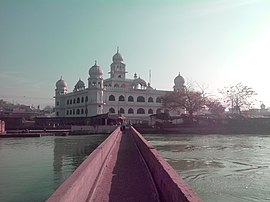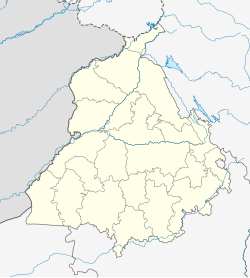This article needs additional citations for verification. (May 2010) |
Kiratpur, also known as Kiratpur Sahib, (lit. "city of glory") is a town, just 30 km from Rupnagar city in Rupnagar district of Punjab, India. The town is the location of the Gurdwara Patal Puri where many Sikhs take ashes of their deceased.[1]
Kiratpur Sahib
Patalpuri sahib | |
|---|---|
Town | |
Gurdwara Charan Kamal, Gurdwara Patalpuri Sahib, Bridge KPS. | |
| Coordinates: 31°10′55″N 76°33′49″E / 31.1820758°N 76.5635490°E | |
| Country | |
| State | Punjab |
| District | Rupnagar |
| Established | 1627 |
| Founded by | Guru Hargobind Sahib ji |
| Population (2011) | |
| • Total | 2,348 |
| Languages | |
| • Official | Punjabi |
| Time zone | UTC+5:30 (IST) |
| PIN | 140115 |
| Telephone code | 01887 |
| Vehicle registration | PB-16 |
| Coastline | 0 kilometres (0 mi) |
| Nearest city | Anandpur Sahib |
Kiratpur Sahib Town
editKiratpur Sahib (31.1820758°N 76.5635490°E) was established in 1627 by the 6th Sikh Guru, Guru Hargobind, who bought the land from Raja Tara Chand of Kehlur through his son, Baba Gurditta. The place is also associated with the memory of a Muslim saint, Pir Buddan Shah.
It is situated on the bank of the Sutlej about 10 km south of Anandpur, about 30 km north of Rupnagar and 90 km from Chandigarh on the Nangal-Rupnagar-Chandigarh road (NH21).[2][3]
It is a sacred place for the Sikhs. Guru Nanak Dev is said to have visited this place when it was little more than a wilderness. Guru Hargobind, the sixth Guru spent the last few years of his life here. Both Guru Har Rai and Guru Harkrishan were also born at this place and they received the Gurgadi (Guruship) at this place.[4]
There is a reference to this place in the hit film, Veer-Zaara (2004). Zohra Sehgal, plays a character in this movie whose last wish is that her ashes should be immersed in Kiratpur.
History
editKiratpur Sahib was founded by the sixth Guru Sri Hargobind Sahib. Here the seventh and eighth Gurus were born and brought up. It was here that Guru Gobind Singh along with his followers received the sacred head of the ninth Guru Sri Tegh Bahadur, brought from Delhi with great devotion and respect by Bhai Jaita in 1675. The particular spot associated with and sanctified by it, is known as Gurudwara Babangarh Sahib. The tenth Guru took the sacred head of his father in a procession to Anandpur Sahib for cremation. The Punjab Government has constructed a pillar here, on which is inscribed the following quotation from Guru Gobind Singh describing the unique martyrdom of Sri Guru Tegh Bahadurji, "The Lord (Guru Tegh Bahadur) protected their paste mark (Tilak) - and the sacred thread. A great deed he enacted in the age of kala (darkness)".
The city and its many Gurdwaras are sacred places for the Sikhs as several of the Sikh Gurus visited, were born and lived here. The ashes of several Gurus were immersed in the nearby Sutlej River. Even today many Sikhs come here to spread the ashes of their loved ones in the River.
The area is also associated with the memory of a Muslim saint, Pir Buddan Shah who was gifted with a very long life (local legends say about 800 years).
The Gurdwara is situated on the bank of the river Sutlej about 10 km south of Anandpur and about 30 km north of Rupnagar. It is on the Nangal-Rupnagar-Chandigarh road (NH21).
People from Kiratpur Sahib
edit- Kanshi Ram, Ex. Member of Parliament, Former Leader of Bahujan Samaj Party
- Dr. Rattan Chand, IAS, Senior Bureaucrat, Government of India.
Religious Places
editGurdwaras
editThere are many gurdwaras in the town:
- Gurdwara Patalpuri Sahib (Kiratpur Sahib[1]
- Gurdwara Baba Gurditta (Kiratpur Sahib)
- Gurdwara Babangarh Sahib (Kiratpur Sahib)
- Gurdwara Shish Mahal Sahib (Kiratpur Sahib)
- Gurdwara Manji Sahib
- Gurdwara Charankamal Sahib
- Gurdwara Sri Hargobindsar Sahib (Dadhi)
Gurdwara Patal Puri
editThis Gurdwara, on the banks of the Sutlej, is situated near the railway tracks and is the place where many Sikhs take the ashes of their deceased to be immersed in the river. Guru Hargobind in 1644, as well as Guru Har Rai in 1661, were both cremated here. The ashes of Guru Harkrishan were brought from Delhi and immersed here in 1664.[5] The gurdwara suffered from long queues during the COVID-19 pandemic.[1]
Gurdwara Babangarh Sahib
editBhai Jaita (Jiwan Singh after baptism), in defiance of the Mughal authorities had managed to escape with the martyred head of the 9th Guru Sri Guru Tegh Bahadur from Delhi after his martyrdom in 1675. It was first rested here. From Gurdwara Teer Sahib the 6th Guru had revealed Gurdwara Patal-Puri by shooting an arrow. The 7th Guru was cremated at Patal Puri and ashes of the 8th Guru were immersed in river Satluj nearby. Gurdwara Baba Gurditta is located on a hill close by.
Gurdwara Shish Mahal
editGurdwara Shish Mahal in Kiratpur has been constructed on the site of the first building completed in the then New city of Kiratpur. Though the first building completed, it was not the first begun as the laying of Kiratpur Sahib's 'foundation stone' had preceded it. This was the home of Baba Gurditta, Guru Hargobind's eldest son, which later also served as the home of his father Guru Hargobind when he moved to Kiratpur Sahib in May 1635. Before leaving Kiratpur in 1635 the Guru's sons—the later Gurus—Guru Har Rai and Guru Harkrishan were both born here. Guru Har Rai's son Ram Rai and his daughter Bibi Rup Kaur were also born here.
First built as the home of Baba Gurditta Guru Hargobind later established his residence here. Both Sri Guru Har Rai Ji and Sri Guru Harkrishan Ji were born in the residence
Gurdwara Charankamal Gurudawara
editit commemorates the spot where the Pir had met the 1st Guru of Sikhism, Sri Guru Nanak Dev Ji. His mausoleum is located on a hill nearby. He died after the Guru Hargobind had established Kiratpur.
Gurdwara Baba Gurdita Ji
editGurudwara Baba Gurditta Ji is situated in the city Kiratpur Of Ropar District. It stands on the top of the hill, about one km from the town and built in memory of Baba Gurditta Ji(Son of GURU HARGOBIND SAHIB JI) and Baba Sri Chand Ji. Baba Gurditta Ji died at this place.
Gurudwara Sri Hargobindsar Sahib
editGurudwara Sri Hargobindsar Sahib is located at the historical village Dadhi hardly a Kilometre from Kiratpur Sahib.
Dargah
edit- Dargah of Baba Budhan shah Ji is also there.
Temples
editShree Rama Mandir
editThis is one of the ancient temple of the town, which is situated in the main market of the town. Every year jagran is held by the committee of this mandir. And other religious activities are carried out on the special occasions.
Shree Bhatukeshwar Durga Mandir
editThis temple was later established in 2004. It is near the postoffice of the town. In this temple also every year jagran and other religious programs are heldby the committee of the temple and by Yuva mandal.
Education
editGovt Sr Sec Sch Kiratpur Sahib High School is one of the most prestigious school in the District. this school has established a brilliant record of academics, and remarkable achievements in sports and culture.
See also
editFurther reading
editHarjinder Singh Dilgeer, Keeratpur Sahib Da Ithas (in Punjabi), Sikh University Press & Singh Brothers Amritsar, 2004
References
edit- ^ a b c Khanna, Ruchika M. (22 May 2021). "At Gurdwara Pataalpuri in Kiratpur Sahib, long queues for immersion of ashes". The Tribune. Retrieved 8 September 2023.
- ^ "快3app-快3app(北京)有限公司". Archived from the original on 25 February 2021. Retrieved 22 December 2009.
- ^ Grewal, J.S. (8 October 1998). "4 -Transformation of the Sikh Paanth (1606-1708)". In Gordon Johnson; C. A. Bayly; John F. Richards (eds.). The Sikhs of the Punjab (New Cambridge History of India) (The New Cambridge History of India) Share your own customer images Search inside this book The Sikhs of the Punjab (New Cambridge History of India) (The New Cambridge History of India) (Paperback) (New ed.). Cambridge University Press. p. 65. ISBN 978-0-521-63764-0. Retrieved 22 December 2009.
- ^ "Kiratpur Sahib". Archived from the original on 7 September 2009. Retrieved 22 December 2009.
- ^ "Gurudwara Kiratpur Sahib".


